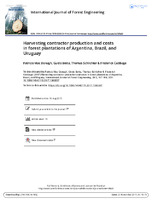Harvesting contractor production and costs in forest plantations of Argentina, Brazil, and Uruguay
Date
2017-08-18Author
Mac Donagh, Patricio Miguel
Botta, Guido
Schlichter, Tomás Miguel
Cubbage, Frederick W.
Metadata
Show full item recordAbstract
Timber production from forest plantations has increased substantially in South America in the last few decades. The timber harvesting process is carried out mainly through logging contractors. This research developed production and cost 'functions for logging contractors working in Misiones and Corrientes (Argentina), Paraná, Santa Catarina and Rio Grande do Sul (Brazil) and Uruguay. Data were obtained from surveys: 22 in Argentina, 35 in Brazil and 10 in Uruguay between 2008 and 2012. When considered as a share of the total production region, we sampled a weighted average of 21% of the firms, which means an annual production of 17.7 million cubic meters. Regressions of the variables species, operations, contractors and mechanization indicated that the logging costs per ton were higher in Uruguay, as were logging contract prices. The contract prices paid for thinning were significantly higher than those of clearcutting, but average logging costs did not differ significantly. A large amount of capital was needed to begin operations, but there was an inflection in the average cost curves at 50,000 tons/month, and average costs were asymptotic at 100,000 tons/month. Logging contractors working for pulp companies have significantly higher capital value and the largest payroll. The fully mechanized logging firms had the highest capital costs. The Cobb-Douglas function was best to estimate production and cost models. Last, the size of the logging firms in these three countries was larger than those reported for southeastern USA and for Scandinavia. However, average costs were not as low as reported in those countries.
Collections
The following license files are associated with this item:




